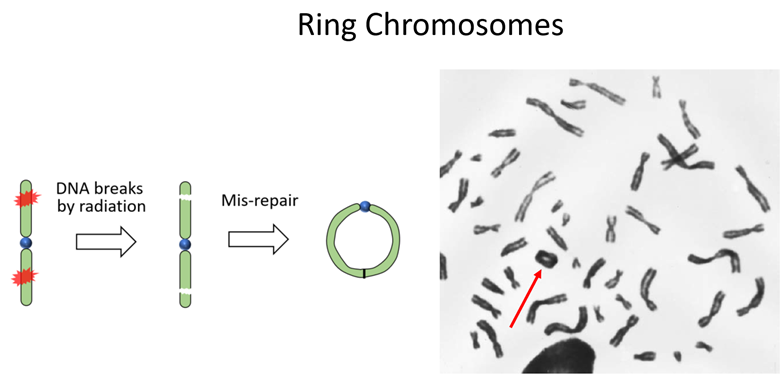Chromosome aberrations [with exercise questions]

Chromosomal aberration, or chromosomal mutation, is a missing, extra, or irregular portion of chromosomal DNA. These can occur in the form of numerical abnormalities (gains and losses) or structural abnormalities (deletions, inversions, and exchanges). Generally, chromosomal aberrations are going to be deleterious and lead to many genetic diseases. Numerical abnormalities can result in spontaneous abortions and severe birth defects. Structural abnormalities can lead to birth defects, cancer, and other late onset disease outcomes.
Duplication
Duplication mutation is gene sequence that is repeated several to hundreds of times. It can occur in normal chromosomes and may have adaptive advantages in fact. For example, useful mutations may occur in the copy of the original gene. Basically, the original gene provides a stable fallback, like a safety net, and the new gene can have mutations, like an experiment to express extra protein. Sometimes, the person who has duplication mutations can be completely unaffected.

Deletion
Deletion mutation results in the loss of some segment of a chromosome. Now, most deletion mutations are either lethal or will tend to cause serious disorders unlike the duplication mutation. For example, a disease called cri-du-chat is caused by the deletion mutation in the upper arm of chromosome 5. The deletion can lead to mental retardation and malformed larynx as well as obvious physical appearances.

Inversion
Inversion mutation is a chromosome rearrangement in which a segment of a chromosome is reversed end-to-end. An inversion usually occurs when a single chromosome undergoes breakage and rearrangement within itself. It can lead to two potential issues: 1. The inversion may bring together genes that were not previously close to each other especially the regulatory regions of some genes, which could cause those genes turned on or off at the wrong time. 2. Any crossover of two genes due to inversion can lead to wrong productions of proteins related to these genes.

Translocation
Chromosome translocation is a phenomenon that results in unusual rearrangement of chromosomes. It includes balanced and unbalanced translocation with two main types: reciprocal- and Robertsonian translocation. Most translocation is reciprocal. Reciprocal translocation is a chromosome abnormality caused by exchange of parts between non-homologous chromosomes. Two detached fragments of two different chromosomes are switched. The non-homologous chromosomes don’t have the same genes. Therefore, there is no conspecific information to exchange. The result is that one chromosome missing some material and the other chromosome now has added material. There are two potential problems associated with it. If the missing gene is critical, the individual who got the shorter chromosome (the top one in the diagram) will definitely have problems. Moreover, if the duplication of these genes is inappropriate, any individual carrying the longer chromosome (the bottom one in the diagram) will also be affected.

Aneuploidy and Polyploidy
Another way to have abnormal chromosome is in the form of numbers. Aneuploidy is the presence of an abnormal number of chromosomes in a cell, such as a human cell having 45 or 47 chromosomes instead of 46 ( Normally, humans have 23 pairs of chromosomes). Any number above or below 46 will tend to be termed. It is one of the major causes of human reproductive failure. In most case, the miscarriage of a woman is because of aneuploidy. On the other hand, polyploidy is a kind of different situation where the cell does not have an extra one or two chromosomes but a duplication of every chromosome. For example, in polyploidy, these individuals have three or more of each type of chromosomes (3n or 4n) instead of having the usual 2n number like human do. In human, this condition is lethal. Most of these individuals die before birth.

Ring chromosomes

Chromatid Bridge

This page has been viewed times.